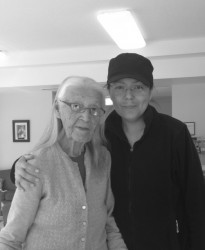Article Origin
Volume
Issue
Year
Grandmother’s kindness and wisdom helped a nation
As Nov. 8, the birth date of her late grandmother, came and went a few weeks ago, Tanya Kappo reflected on the words written on her mentor’s gravestone.
“She passed away last March. This month, she would have been 94 years old,” Tanya said. “I was thinking a lot about her and came to a realization. If I want to leave any kind of an impression in this world, it is to have people remember me as having had the same qualities as my grandmother.”
Tanya referred to the words written on Mary Kappo’s gravestone: “A woman of Grace, Virtue, Kindness and Modesty. A tender heart and generous Spirit.”
Born on Nov. 8, 1921, the only daughter of five children raised by Abraham Moses and Philomene Noskey, Mary witnessed more than her share of loss in her life, yet remained strong and compassionate. Her mother died when she was only a child, and her trapper father took her to the Sturgeon Lake Indian Residential School to be raised by nuns. Although it was a place that left terrible memories for many, she never spoke badly of her own experience.
“She focused on the positive things, like learning to read, write, sew, play instruments and cook,” Tanya explained.
Son Richard Kappo, chief of the Sturgeon Lake First Nation, said what stands out for him about his mother was that she never spoke poorly of anyone, and that she sewed exquisite moccasins and mukluks.
“She made sure everyone got something for Christmas. She couldn’t stand the idea of someone going without anything for Christmas so she made things and shopped for everyone,” he said. “When she couldn’t shop for presents as she got older, she gave gifts of money to the family.”
Mary was such a devout Catholic that she was headed for the convent to become a nun upon graduating from school. That was until Dave Capot came into the church and saw her. The two married in July, 1940, with a nun as their maid of honour, and a brother as their best man. As Dave’s second wife, Mary became an immediate mother to his two young children, Howard and Evelyn; together Dave and Mary had 10 more children.
Happily, the marriage brought two mother figures into her life: mother-in-law Charlotte, and grandmother-in-law Madeleine. Under their tutelage, she reconnected with Indigenous ways and re-learned her Cree language. Soon, she was trapping and hunting small game to help feed her family. She cleaned animals, tanned hides and prepared lynx, marten and rabbit fur, teaching her children the same skills.
Even though her domestic chores never ended, she supported her husband as chief of the Sturgeon Lake Cree Nation, and often travelled with him to Indian Association of Alberta meetings.
Mary suffered more loss in 1972. Not only did she lose her 15-year-old son Harold in a car accident, she and Dave were also in an automobile collision, resulting in her almost losing her leg. Nearly completely severed, doctors thought she would never walk on it again. Luckily, one physician believed the limb could be re-attached and sent her to a larger hospital; following months of physical rehabilitation she regained the use of it.
Recuperation was slow, but never one to dwell on negativity, Mary honed her beading skills while she was laid up, creating distinct designs on the hide jackets, gloves and moccasins she sewed.
Hardly having time to grieve the loss of son Howard in a 1977 vehicle accident, Mary faced the death of her beloved husband later that year. Though she missed him terribly, she said she took joy in seeing a part of him in her children and grandchildren.
Now it was her responsibility to lead the family, and she made sure informal family gatherings took place regularly, almost every time a moose was brought home. She led the efforts at the meat racks to cut and dry it for pansawan (drymeat).
Yet another car accident would take its toll in 1978, leaving her grandson Dougie dead and her son Edwin paralyzed from the waist down; Mary became his day-to-day caretaker.
Resolving to take a role in leading her people, beyond just her family, Mary served two terms as a councillor for her nation, and devoted herself to children’s advocacy. She lobbied chiefs to create a child welfare agreement for the Lesser Slave Lake Regional Council, and was active on child welfare advisory groups until health reasons required her to move into extended care. She also attended Elders meetings for the Treaty 8 First Nations of Alberta.
“She never spoke often, but when she did, she had something to say and people listened,” said Tanya.
When sewing hide became difficult, Mary knitted socks and gifted many pairs to students at the Sturgeon Lake School. “You could be talking to her about something so serious, and she’d be right there with you, but her fingers would be moving fast without her even looking down,” said daughter Margaret. “She kept her mind sharp, too, by making puzzles, working on word-find puzzles, and reading her romance novels.”
Long chats with son, Richard, kept him focused on being a good chief, especially when hard decisions had to be made, and Mary never tired of helping her family and other band members.
“She was my biggest cheerleader in law school,” said Tanya. “Sometimes the going was rough, but I knew I had to keep going. There was no way I could let her down.
“Despite the fact there are so many challenges facing our people, she was always able to see that goals could be made and accomplished. She was honest, and giving, and kind to everyone, not just her family. She treated Indigenous and non-Indigenous people the same way. She was like a grandmother to everyone.”
- 3464 views

